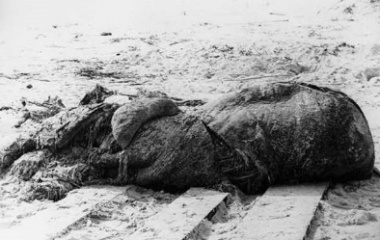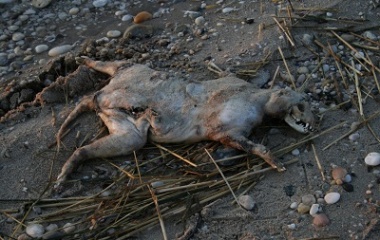What is a Globster?
A Globster (or a blob) is an unidentified carcass that washes up on the sea shore. Controversies often arise over these smelly lumps of flesh, as biologists and cryptologists battle for the right to attach names to the creatures.
Characteristics
Physical Description
Globsters come in many colors, shapes, and sizes. Purists describe these creatures as having no bones and no readily identifiable organs, but the public embraces a wider image. The monstrous bodies might have skeletons, tentacles, tusks, and bristles covering their mass. Even so, their bodies are usually difficult to map out; they might seem to lack a head or tail, and they often have strange, oozing lobes that resemble arms. They range from colorless to rusty pink or dark blue-black, and they can measure over sixteen meters and four tons.
Famous Globsters
The first documented globster was a carcass that washed up on a Mexican beach, Santa Maria del Mar, in 1648. Details of this carcass have been lost to time, but it was only the beginning of a phenomenon which would draw attention from science and the media for centuries to come.
Stronsay Beast
A stormy night in 1808 delivered up a beast on the shores of Scotland’s Orkney Islands. At 16.8 meters long, it is the longest Globster on record, and locals speculated that the creature was missing its tail, meaning that it was even larger in life. It had three pairs of fins, edged in bristles, and a mane of bristles down its back. Eerily, a handful of witnesses claimed that the bristles glowed in the dark.
When a representative of Edinburgh’s Natural History Society was unable to identify the creature, Scottish scholars flocked to the beach to see the creature. One scholar claimed it was a new species of sea serpent, while others claimed it was a plesiosaurus (previously believed to be extinct). Later, a wave of skeptics denounced the beast as a basking shark, even though the largest basking shark on record was 12.2 meters long.
St. Augustine Monster
In 1896, two young boys were bicycling along the shores of St. Augustine, Florida, when they came upon a schoking discovery: a huge, gelatinous carcass. The carcass was partially buried, so the boys only poked at it for a few minutes before returning to town and telling a doctor what they had seen.
The carcass was pinkish in color and had a silver sheen in the sunlight. Although it looked gelatinous, it was very difficult to cut through. It had four stumps, which appeared to be severed arms. Later, the creature’s tentacles were found strewn about the beach. They were seven meters long. The creature was estimated to weigh five tons or more.
At first, scholars from St. Augustine and the Smithosonian were unanimous in declaring the creature a giant squid or a previously undiscovered species of giant octopus. After tissue samples were performed, however, many scientists changed their mind, asserting that the Globster was actually a mass of blubber from a sperm whale.
The tissue was re-tested three times by various scientists in the 1971, 1986, and 1995. The first two re-tests supported the idea that the creature had, indeed, been an octopus. They claimed that the tissue material was too tough to be blubber, and the cellular filaments and ammino acids found inside the tissue resembled octopus collagen more than whale blubber. The final study, in 19995, returned to the position that the St. Augustine Monster was, in fact, a whale—but rather than being blubber, it was a mass of the whale’s tough outer skin.
Tasmanian Globster
In 1960, a five to ten ton monster washed up on the shores of Tasmania. It was so alien and bulbous that the media nicknamed it “the globster,” thus coining the phrase that would be applied to other unidentified carcasses.
It’s bulk contained a spine, and six arm-like protusions blobbed away from its main body. Fine white bristles covered its surface. After analysis of a tissue sample, most scientists concluded that it was the remains of a whale.
In 1970, a similar carcass was reported on a beach nearby, but no concrete evidence of this Globster survived.
Gambo
In 1983, a fifteen-year-old nature enthusiast came upon a bizarre carcass on a beach in Gambia. Intrigued, the young boy took measurements and made sketches of the creature. He claimed that it showed few signs of decomposition. Its skin was smooth, brown on the top and white underneath. It had a domed head, about one meter long, with a beak of almost the same length and small beady eyes. It had a long tail that tapered to point, and it had no dorsal fin. Most curious of all, it had two sets of small, almost foot-like flippers.
No evidence, other than the young boy’s drawings and measurements, was collected from the creature. It’s head was cut off for a tourist, and its body was buried. No tissue samples were obtained.
Some scholars dismess the creature as no more than a boy’s imagination—or even a story made up to get attention. Gentler scientists accept the story but explain the creature as a beaked whale, whose body had been mangled to create the appearance of four flippers. Only a handful of cryptozologists believe in the most exciting possiblities for Gambo: that he was a prehistoric reptile, possibly a pliosaur or mosasaur.
Blobs
During the 1980s and 1990s, various white “blobs” washed ashore all over the world. They ranged in size from less than a meter to twelve meters, and they all had blob-like protrusions for “arms” and fine white bristles on the surface. Almost all of them were identified as whale blubber. The most famous blobs came from Bermuda, Scotland, Chile, and Canada.










